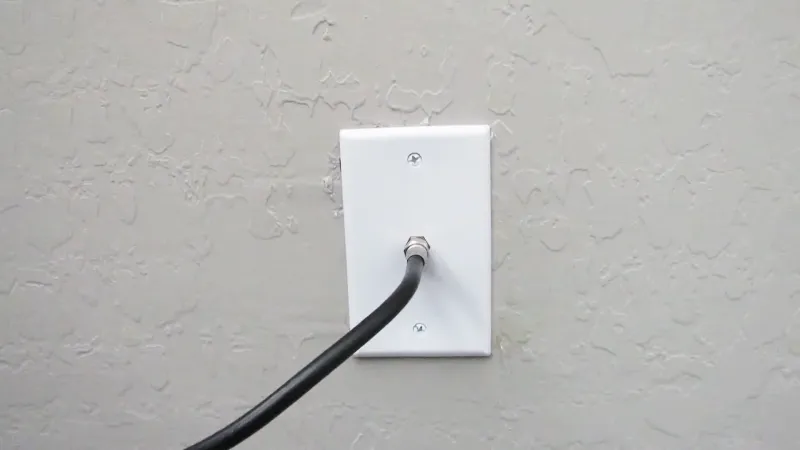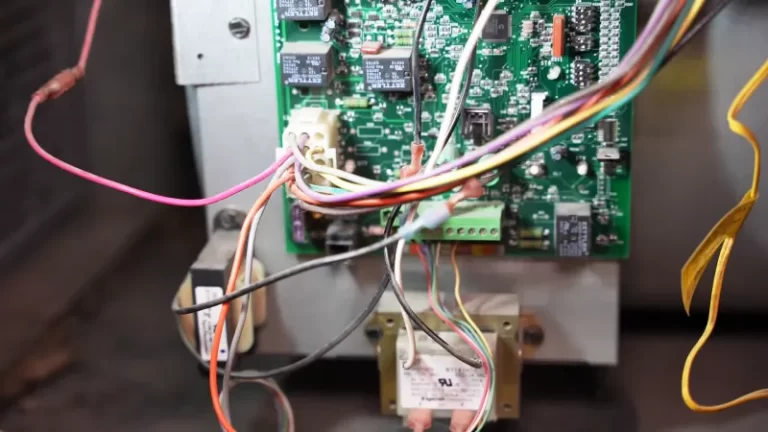Why Do Coax Cable Coming Out of Wall?

Coaxial cable, or coax, is a type of electrical cable that is commonly used in homes and businesses to transmit television and internet signals. It is characterized by its outer layer of insulation, which surrounds a single wire or conductor.
If you have a coax cable coming out of your wall, it is likely that it was installed to provide a connection for a TV, cable modem, or other electronic device. In this article, we will discuss options for hiding or removing the coax cable and important considerations for ensuring the work is completed safely and effectively.
You'll Learn About
Coax Cable Coming Out of Wall
Coaxial cable, or coax, is a type of electrical cable that is commonly used for transmitting television and internet signals. It is characterized by its outer layer of insulation, which surrounds a single wire or conductor. Coaxial cable is often used in homes and businesses to connect TVs, cable modems, and other electronic devices to a source of signal, such as a cable television or internet service provider.
Power Perticular Devices
If you have a coax cable coming out of your wall, it is likely that it was installed to provide a connection for one of these types of devices. The cable may have a male end that is intended to be plugged into the device, or it may have a female end that can be used to connect additional cables or devices.
Removeing the Cable
If you no longer need the coax cable and want to hide it or remove it, there are a few options you can consider. One option is to cut the cable and cap the end with a female connector, which will allow you to easily remove it or attach additional cables as needed.
Conceal the Cable
Another option is to use a low voltage electrical box and blank cover plate to conceal the cable within the wall. Alternatively, you could simply cut the end off the cable and pull it out of the house, although this may not be an option if the cable is connected to other devices or cables outside the house.
Regardless of which option you choose, it is important to take proper safety precautions and follow any necessary instructions or guidelines to ensure that the work is completed safely and effectively.
Options for Hiding or Removing Coaxial Cable
If you have a coax cable coming out of your wall and no longer need it, there are a few options you can consider for hiding or removing the cable.
Cap With a Female Connector
One option is to cut the end of the cable and cap it with a female connector.
This will allow you to easily remove the cable or attach additional cables as needed. To do this, you will need a coax cable stripper and a female connector. First, use the cable stripper to carefully remove the outer layer of insulation from the end of the cable.
Then, slide the female connector over the exposed wire and secure it in place according to the manufacturer’s instructions.
Use a Low Voltage Electrical Box
Another option is to use a low voltage electrical box and blank cover plate to conceal the cable within the wall. This will allow you to cut the cable to the proper length and save the excess in case you need it later to hook up a coax cable to the outlet.
To do this, you will need a low voltage electrical box, a blank cover plate, and a coax cable face plate. First, install the low voltage electrical box in the wall according to the manufacturer’s instructions.
Then, attach the coax cable face plate to the box and run the cable through the face plate. Finally, attach the blank cover plate to the box to conceal the cable and the face plate.
Cut and Pull Out
A third option is to simply cut the end off the cable and pull it out of the house. This may not be an option if the cable is connected to other devices or cables outside the house, but if the cable is not being used and there is no need to keep it for future use, this can be a quick and easy way to remove it.
To do this, use a cable stripper to carefully remove the outer layer of insulation from the end of the cable. Then, cut the end off the cable and pull it out of the wall.
Safety Considerations
When hiding or removing a coax cable coming out of your wall, it is important to take proper safety precautions and follow any necessary instructions or guidelines. Coaxial cable typically carries low voltage signals and is not considered a significant electrical hazard, but it is still important to handle it with care to avoid damaging the cable or causing any other issues.
Follow Manufacturer Instructions
One important safety consideration is to follow the instructions provided by the manufacturer of any tools or equipment you are using. This includes using the correct tools for the job and following the instructions for their use. For example, if you are using a coax cable stripper, be sure to read and understand the instructions for using the tool before you begin stripping the cable.
Properly Grounded
Another important safety consideration is to ensure that you are properly grounded when working with electrical components. This can help to protect you from electrical shock and prevent damage to the equipment. You can do this by wearing rubber-soled shoes or using a grounding strap.
Take Appropriate Precautions
Be sure to take appropriate precautions to protect yourself and others from injury. This may include wearing protective eyewear, gloves, and other appropriate personal protective equipment. It is also important to keep tools and equipment out of the reach of children and pets.
By following these and other safety guidelines, you can help to ensure that your work is completed safely and effectively.
Tips to Consider When Hiding or Removing a Coax Cable
Here are a few additional tips to consider when hiding or removing a coax cable coming out of your wall:
Check With Your Service Provider
If you are unsure whether you need the coax cable or if you have any concerns about removing it, it is a good idea to check with your cable or internet service provider. They may be able to provide you with more information about the cable and any potential consequences of removing it.
Label the Cable
If you are cutting the cable and keeping a portion of it for future use, it is a good idea to label the cable with a piece of tape or a marker. This will help you to identify the cable later on if you need to use it again.
Use Cable Ties
If you are cutting the cable and pulling it out of the house, you may want to use cable ties to secure the excess cable in place. This will help to keep the cable organized and prevent it from getting tangled or damaged.
Test the Connection
After hiding or removing the cable, be sure to test the connection to ensure that it is still functioning properly. This is particularly important if you are removing the cable from a device that relies on it for a signal, such as a TV or cable modem.
Consider the Length of the Cable
If you are cutting the cable and keeping a portion of it, be sure to consider the length of the cable when determining how much to keep. You may want to keep enough cable to reach the device or outlet that you will be using it with, but not so much that it becomes difficult to manage or store.
Write About Things to Know or Things Needed:
There are a few things to consider or items that you may need when hiding or removing a coax cable coming out of your wall:
Tools
Depending on the option you choose, you may need certain tools to complete the job. For example, if you are capping the end of the cable with a female connector, you will need a coax cable stripper and a female connector. If you are using a low voltage electrical box, you will need a drill, screws, and other tools to install the box and attach the cover plate.
Safety Equipment
It is important to take proper safety precautions when working with electrical components. This may include wearing protective eyewear, gloves, and other appropriate personal protective equipment.
Instructions and Guidelines
Be sure to follow any instructions or guidelines provided by the manufacturer of the tools or equipment you are using. This will help to ensure that the work is completed safely and effectively.
Service Provider
If you are unsure whether you need the coax cable or have any concerns about removing it, it is a good idea to check with your cable or internet service provider. They may be able to provide you with more information about the cable and any potential consequences of removing it.
Cable Ties
If you are cutting the cable and pulling it out of the house, you may want to use cable ties to secure the excess cable in place. This will help to keep the cable organized and prevent it from getting tangled or damaged.
Labels
If you are cutting the cable and keeping a portion of it for future use, it is a good idea to label the cable with a piece of tape or a marker. This will help you to identify the cable later on if you need to use it again.
Also Read – Why Is Copper No Longer Used For Busbars?
Final Thoughts
There are a few options available for hiding or removing a coax cable coming out of your wall. These include capping the end with a female connector, using a low voltage electrical box and blank cover plate, or simply cutting the end off and pulling it out of the house.
Whichever option you choose, it is important to take proper safety precautions and follow any necessary instructions or guidelines to ensure that the work is completed safely and effectively. Proper planning and execution are also key to ensuring that the job is done correctly and that the cable is properly hidden or removed.
By following these guidelines, you can help to ensure that your work is completed smoothly and without any issues.

